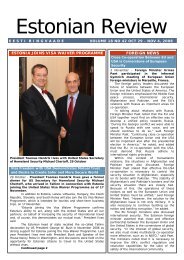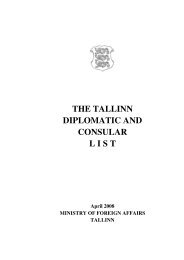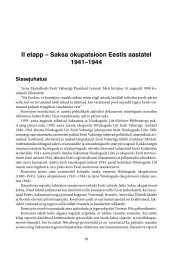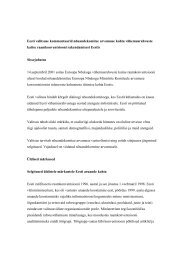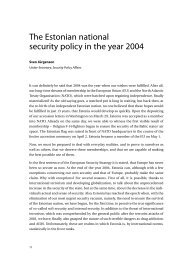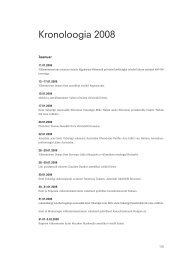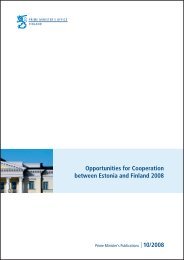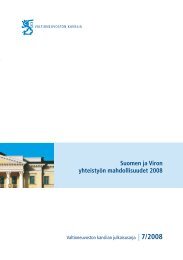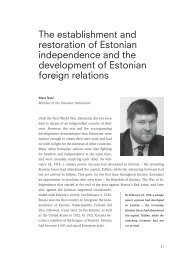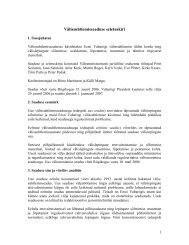Create successful ePaper yourself
Turn your PDF publications into a flip-book with our unique Google optimized e-Paper software.
April 2008<br />
growth and was named as the main constraint by 19 percent of managers in the first quarter of this year,<br />
compared with 36 percent in the first quarter of 2007. In the construction sector the ratio of such companies<br />
dropped from 51 percent to 8 percent. Insufficient demand was named as the most important factor by 58<br />
percent of construction companies in the latest survey, up from 44 percent in December. The good news is that<br />
a third of construction companies are planning to cut prices in the near future. For the government this creates a<br />
good backdrop for making investments and the state should consider going on with planned investments<br />
despite the harder times that have arrived.<br />
• A survey on consumer protection conducted by the <strong>Estonian</strong> Institute of Economic Research shows<br />
that people's awareness of the fact that such a thing as consumer protection law exists has risen to 84<br />
percent, or the same level as in the late 1990s. One-sixth of the population is unaware of the existence of<br />
such a law. At the same time, among Russian-speaking respondents those not aware of the existence of the<br />
Consumer Protection Act made up nearly a quarter of respondents. One-third of the respondents said they had<br />
at least once been disappointed after making a purchase on the basis of an advertisement.<br />
MAJOR ECONOMIC INDICATORS<br />
• Increase in Estonia's exports and imports slowed down in 2007 compared to 2006 and the annual rate<br />
of growth for 2007 was the lowest of the years since the country joined the EU. The export of goods<br />
made up 125.5 billion kroons and import 177.1 billion kroons in 2007. In yearly comparison the value of<br />
exports increased 4 percent and of imports 6 percent, the smallest such figures for the last four years. The<br />
slowdown was partially the result of the rapid growth rate of exports and imports in 2006, when the annual<br />
growth rates were 24 percent and 30 percent, respectively. The trade deficit amounted to 51.6 billion kroons, a<br />
11 percent larger figure than in the year before. In 2006, Estonia's foreign trade deficit expanded by as much as<br />
47 percent. The share of EU countries was 70 percent and that of CIS countries 11 percent in exports. Exports<br />
to EU countries grew 11 percent compared to 2006 while exports to CIS countries were up 14 percent. In<br />
imports the share of EU countries was 78 percent and the share of CIS countries was 13 percent. Imports<br />
from EU countries increased 11 percent but imports from CIS countries dropped 13 percent in comparison<br />
with 2006.<br />
• The number of bankruptcies has considerably increased in Estonia in Q1 compared with the same<br />
period last year. If 72 bankruptcy applications were filed to the Harju County Court in the first 3 months of<br />
2007, then this year there were 119 such applications. In the Tartu and Viru County Courts the number of<br />
bankrutcy proceedings has not increased.<br />
FISCAL POLICY<br />
• The inflow of income tax and VAT revenues into the state budget of Estonia in the first quarter of this<br />
year was smaller than at the same time a year ago. VAT revenues in the first three months of 2008 totaled<br />
4.694 billion kroons (EUR 299.94 mln), making up 92 percent of the sum collected in Q1 of 2007 and 18<br />
percent of this year's target. The intake of personal and corporate income tax, at 698 million kroons, formed 90<br />
percent of the inflow in the first three months of last year and 8 percent of the sum planned for this year. The<br />
personal income tax revenue is at that negative, in other words, tax refunds exceed the sum collected.<br />
Corporate income tax revenue in the three months made up almost 18 percent of the year's target. The social<br />
tax intake added up to 7.513 billion kroons in the first quarter, 20 percent up from the same period last year<br />
and nearly 23 percent of the inflow projected for the current year. Excise taxes totaled 2.281 billion kroons, an<br />
increase of 29 percent year-on-year and 22 percent of the 2008 plan. All told, first-quarter tax intake was 18.394<br />
billion kroons or 11 percent more than at the same time last year.<br />
LABOUR MARKET<br />
• The number of registered unemployed residents in Estonia grew 2.6 percent or by 441 people in<br />
March compared with the preceding month to reach 17,181 at the end of the month. Year-on-year, the<br />
rate of increase was 20.5 percent. Unemployed people registered with the Labor Market Board made up 2.7<br />
percent of the entire capable population from age 16 to pension age. In the course of the month of March<br />
19,427 people searched for a job via the Labor Market Board and 1,480 jobless people became employed. The<br />
number of new job seekers registered as unemployed was 2,957. Unemployed people between ages 16-24<br />
registered with the Labor Market Board numbered 2,126 as of March 31, while people aged over 50 numbered<br />
5,360. Women made up 55.7 percent. The unemployment rate was highest in the southern Valga County, 5.8<br />
percent, and lowest in Tartu County, also in South Estonia, at 1.7 percent. In Harju County, which includes the<br />
capital Tallinn, the rate was 1.9 percent.<br />
• Fears of <strong>Estonian</strong> residents as regards unemployment growth are on the rise and consumer<br />
confidence continues to be low, a recent survey indicates. 7 percent of respondents considered it possible<br />
2





